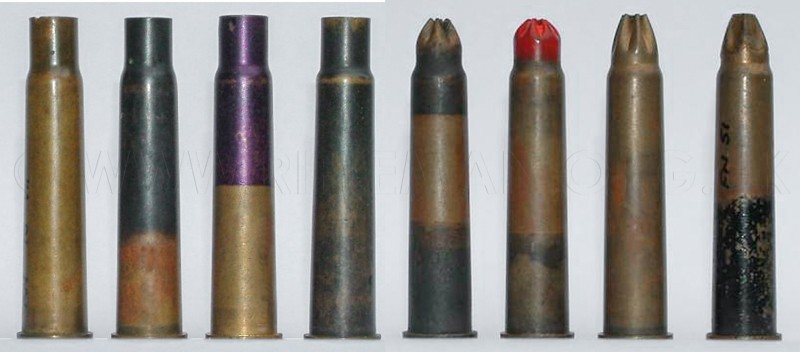2½-inch Discharger Cup for use with the SMLE and No.36 grenade with base plate. Introduced in 1917.
Prior to the very first issue of the Mills bomb in May 1915, there were a number of hand grenade designs in use during the early months of the First World War. The need to project grenades, further than was possible by hand, was filled by various designs of grenade heads with rods attached that fitted into the bore of the .303 inch calibre Enfield rifles.
These grenades were launched from the muzzle of the rifle using a cartridge that produced only gas pressure in the barrel. Using a live bulleted cartridge by mistake would result in serious injury, or worse, to the firer and those around him. The early grenade firing cartridges were plain cartridge cases filled with propellant powder and plugged with a hard wax-like compound. Later cartridges were of the more usual crimped neck type, familiar to the many who have been involved in military exercises over the years. The cases of both periods were usually part dipped in a coloured stain to identify their type and purpose.
All WWI grenade discharging cartridges had open necks, but WW2 issue used the rosette crimped .303 flanged cases familiar to all those who have experienced military exercises up to the time the NATO 7.62mm round was introduced in the mid-1950s for the transitional Lee-Enfield rifles and the L1A1 FN SLR (Self Loading Rifle).
Note that, in British military nomenclature, blanks are all just "cartridges", while bulleted cartridges are "rounds".
In 2012, the late Tony Edwards, a noted authority on British Smallarms Ammunition, wrote.
"There is a world of difference between training blanks and Grenade discharging blanks. It is all to do with the burning rate of the powder. If you tried to launch a grenade with a training blank it would probably blow up the rifle.
The "E" in the headstamps is the code for Eley Brothers and the cases are made from reject Mark VII ball cases as has already been pointed out. That "E" is nothing to do with the "E" in "E Mark IT", where the "E" is the code for a smoke generator discharger from armoured vehicles and the "T" indicates it is loaded with Black powder. The E Mark IT was only used for a very short period in the 1930s and no example with that headstamp is known to survive today.
Although the very early grenade discharging blanks in WWI were simply Ball rounds with the bullet removed, specialist rounds were soon developed for firing different grenades. The rounds with the top half blackened are the "Cartridge S.A. .303 inch Rifle Grenade 30 Grains Ballistite Mark I" which changed in 1927 to "... .303 inch H Mark Iz" and was used for launching No.23 and other grenades form the cup discharger. Rounds with the whole case blackened are for rodded grenades and became the H Mark II after the 1927 changes in nomenclature.
The range of rifle projected grenades was considerable, ranges of 300 yards being obtained depending on the grenade.
Moving on from the H Mark I and II I described in my previous post, the H Mark III was an Indian version of the H Mark I, but loaded with cordite as this was more stable in tropical climes.
The H Mark IV (and IVz) is a bit more complicated. The British H Mk.4 (post 1944 the Roman Mark numbers were changed to Indo-arabic) was a British made blank for launching the No.85 Grenade from the No.5 rifle. However, the Australians also introduced a H Mark 4 for launching the grenade from No.1 and No.4 rifles and so had a heavier charge of cordite. Both the British and Australian versions were closed with a rosette crimp and often had a red closing seal.
The H Mark 5 was an Indian and Pakistani cordite loaded version of the H Mark 4 and also had the red closure. Then there was an Indian Carbine H Mark V, but again no known examples exist. Because there were two Mark 5s, the H Mark 6 was omitted and the next round was the H Mark 7z for launching the Energa grenade form the No.4 rifle.
All the H Mark 7z were made by FN, the earliest (1950) had plain brass cases but the later ones (1951 and later) had the lower half lacquered black. That was the last of the .303 Grenade discharging blanks."

Left to right:
H Mark I
Cartridge S.A. .303 inch Rifle Grenade 30 Grains Ballistite Mark I
Cartridge S.A. .303 inch H Mark Iz
H Mark II
British H Mark 4z
Australian H Mark 4
Early FN H Mark 7z
Later FN H Mark 7z